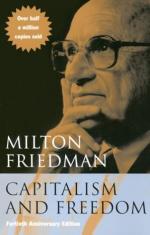|
This section contains 566 words (approx. 2 pages at 400 words per page) |

|
Liberalism
In Friedman's mind, the 17th, 18th and 19th century ideology that emphasized representative government, the rule of law, free enterprise, free trade, the advancement of women, constitutionalism, ending slavery, limitations on state power and the freedoms of speech, religion and the press. Friedman identifies as a liberal.
Capitalism
The economic system that arises in combination with modern industrial institutions and strong private property rights with little government interference. Friedman is a strong proponent of capitalism.
Keynesianism
The economic doctrine of John Maynard Keynes that Friedman rejects and believes has been theoretically and empirically refuted.
Socialism
The social and economic philosophy which holds that the means of production should be owned by the state. Friedman stridently opposes socialism.
Paternalism
The social and political philosophy that holds that some individuals must have decisions made for them by the state because they are unable to take care of themselves. Friedman...
|
This section contains 566 words (approx. 2 pages at 400 words per page) |

|




